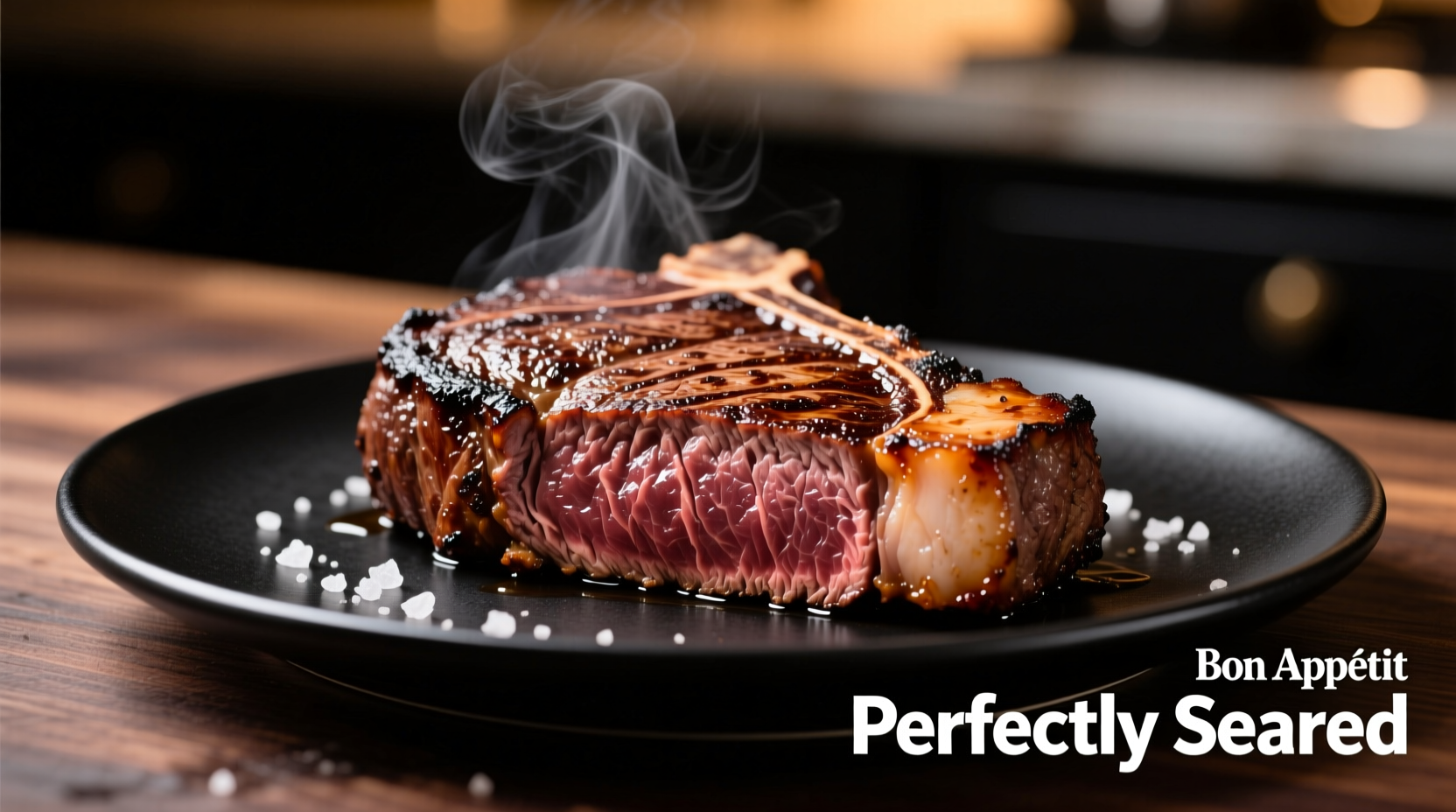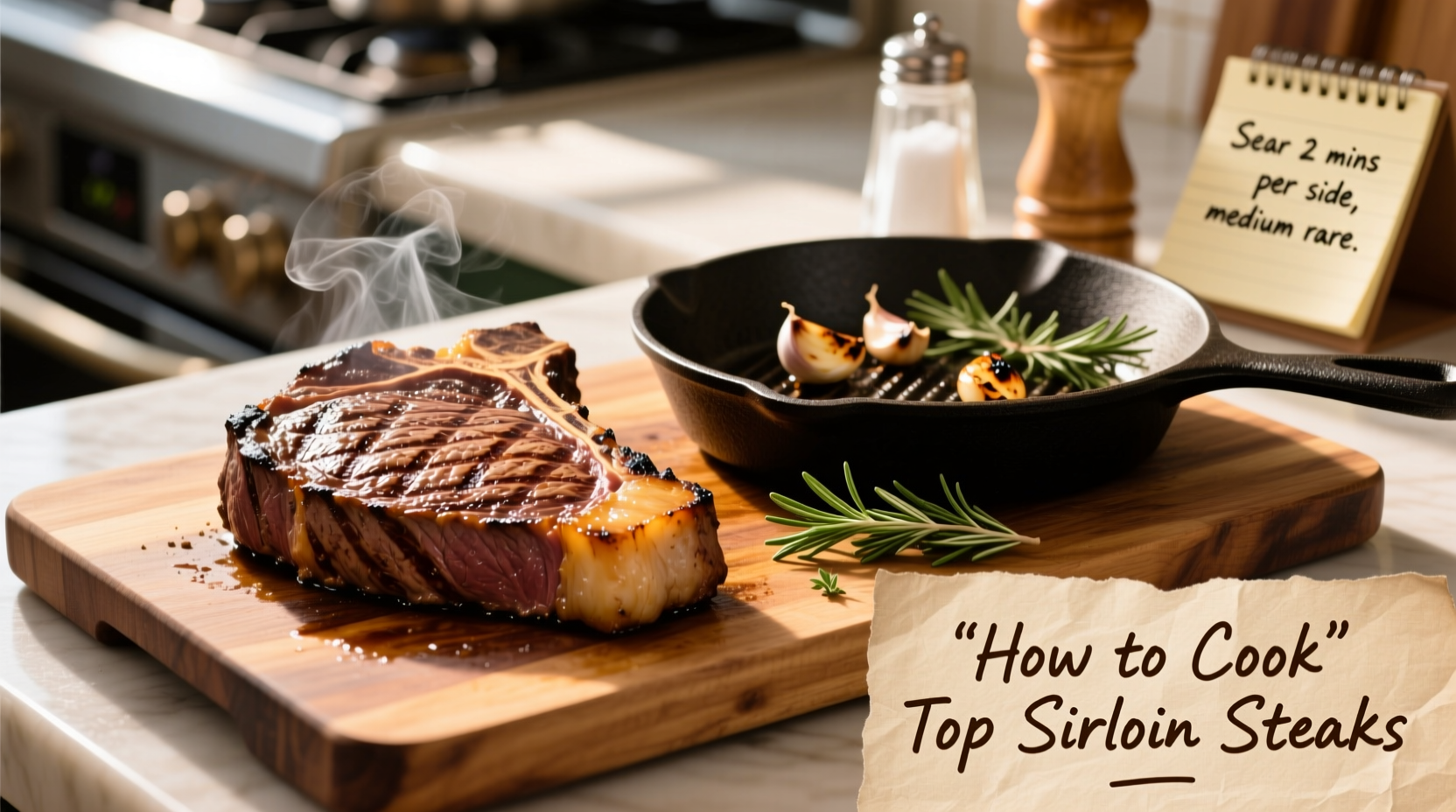Why Top Sirloin Deserves Your Attention
Top sirloin steak offers the perfect balance of flavor, tenderness, and value. Unlike filet mignon's delicate texture or ribeye's rich marbling, top sirloin delivers robust beef flavor with moderate marbling at a more accessible price point. This versatile cut comes from the upper rear section of the cow, making it leaner than ribeye but more tender than regular sirloin.
| Steak Cut | Marbling Level | Price Range (per lb) | Best Cooking Method |
|---|---|---|---|
| Top Sirloin | Moderate | $12-$18 | Pan-sear + finish |
| Ribeye | High | $18-$28 | Grill or broil |
| Filet Mignon | Low | $20-$30 | Pan-sear + oven finish |
| Regular Sirloin | Low | $8-$14 | Marinate + grill |
Preparing Your Steak for Success
Proper preparation makes the difference between good and exceptional steak. Remove your top sirloin from refrigeration 45-60 minutes before cooking to bring it to room temperature—this ensures even cooking. Pat the steak thoroughly dry with paper towels; moisture is the enemy of proper searing. For best results, choose steaks at least 1½ inches thick, which gives you more control over doneness.
Seasoning Strategies That Elevate Flavor
Keep seasoning simple to highlight the natural beef flavor. Generously coat all sides with coarse kosher salt (1 teaspoon per pound) and freshly ground black pepper. For enhanced flavor development, salt your steak 40-60 minutes before cooking—this allows the salt to penetrate while drawing out excess surface moisture. Optional additions include garlic powder (1⁄4 teaspoon) or smoked paprika (1⁄4 teaspoon), but avoid sugary rubs that burn at high searing temperatures.
Mastering the Cooking Process
Follow this professional technique for restaurant-quality results at home:
Pan-Searing Method (Recommended)
- Preheat 12-inch cast iron skillet over medium-high heat for 5 minutes until smoking slightly
- Add 1 tablespoon high-smoke point oil (avocado or grapeseed)
- Place steak in skillet, pressing gently for full contact
- Sear 3-4 minutes until deep brown crust forms
- Flip and sear opposite side 3-4 minutes
- Add 2 tablespoons butter, 2 smashed garlic cloves, and fresh thyme sprigs
- Tilt pan and spoon melted butter over steak continuously for 60 seconds
- Check internal temperature; remove steak at 120-125°F for medium-rare
Grilling Alternative
For outdoor cooking, use a two-zone fire with direct heat at 400-450°F. Sear steak over direct heat for 3-4 minutes per side, then move to indirect heat to finish cooking to desired temperature. Close the lid during the finishing phase to maintain consistent heat.
Temperature Timeline: Your Doneness Guide
Timing varies based on steak thickness and heat source, but internal temperature is your most reliable indicator. Use an instant-read thermometer for accuracy:
- Rare: 120-125°F (1-2 minutes resting) - cool red center
- Medium-rare: 130-135°F (8 minutes resting) - warm red center (recommended)
- Medium: 140-145°F (10 minutes resting) - warm pink center
- Medium-well: 150-155°F (12 minutes resting) - slightly pink center
- Well-done: 160°F+ (15 minutes resting) - little to no pink
According to USDA Food Safety guidelines, beef steaks should reach a minimum internal temperature of 145°F followed by a 3-minute rest time for food safety. However, culinary professionals typically recommend cooking top sirloin to medium-rare (130-135°F) for optimal tenderness and flavor, as this cut maintains moisture better than leaner steaks. USDA Food Safety Inspection Service confirms that consumers may cook beef to lower temperatures based on personal preference, understanding the associated food safety risks.

Critical Resting Phase
Never skip resting! Transfer your cooked steak to a cutting board and tent loosely with foil. Resting time should equal the thickness of your steak in inches (e.g., 1½ inch steak = 8 minutes rest). This allows juices to redistribute throughout the meat. Cutting too soon releases precious juices onto your cutting board rather than staying in the steak.
Slicing and Serving for Maximum Enjoyment
Slice against the grain at a 45-degree angle into ¼-inch thick pieces. Cutting against the grain shortens muscle fibers, making each bite more tender. Serve immediately with simple sides that complement rather than compete with your steak's flavor—roasted vegetables, garlic mashed potatoes, or a fresh arugula salad work beautifully.
Avoid These Common Top Sirloin Mistakes
Even experienced cooks make these errors with top sirloin:
- Overcooking: This leaner cut dries out quickly past medium doneness
- Inadequate resting: Cutting too soon releases juices, resulting in dry steak
- Cold steak: Starting with refrigerated steak causes uneven cooking
- Disturbing too soon: Moving steak before a proper crust forms
- Wrong pan: Non-oven-safe pans limit finishing options
Situation-Specific Cooking Advice
Adjust your technique based on your specific circumstances:
- Thin steaks (under 1 inch): Use higher heat and reduce cooking time by 30-40% to prevent overcooking
- Extra-thick steaks (2+ inches): Sear then finish in 300°F oven until reaching target temperature
- Indoor cooking limitations: Use broiler method with steak 4-6 inches from heat source
- After marinating: Pat extremely dry and reduce initial sear time to prevent burning
Frequently Asked Questions
Should I marinate top sirloin steak? While not necessary due to its inherent flavor, a simple marinade (olive oil, acid, herbs) for 2-4 hours can enhance tenderness. Avoid long marination as acid can make surface mushy.
How can I tell doneness without a thermometer? Use the finger test: compare steak firmness to the fleshy part of your palm below the thumb. Rare feels like when thumb touches index finger, medium-rare like middle finger, medium like ring finger.
Why does my steak stick to the pan? This happens when the pan isn't hot enough or when you try to move the steak too soon. Properly preheated cast iron with adequate oil should release naturally once a crust forms.
Can I cook frozen top sirloin? Yes, but add 50% more cooking time and use lower initial heat to prevent exterior burning before interior cooks through. Thawing is always preferred for optimal results.











 浙公网安备
33010002000092号
浙公网安备
33010002000092号 浙B2-20120091-4
浙B2-20120091-4